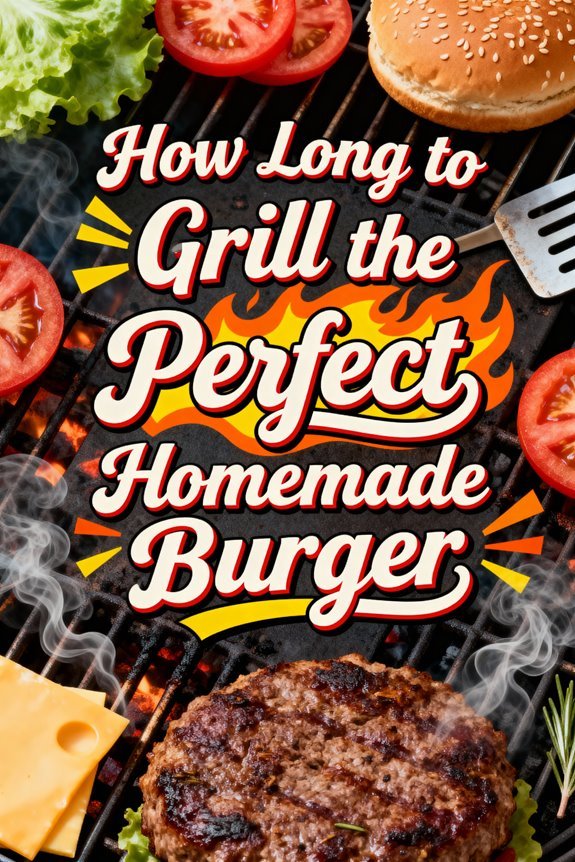Grill fresh sausages for 12-14 minutes using a two-zone setup: start on indirect heat at 225-275°F for 8-10 minutes, then sear over direct heat at 450-550°F for 2 minutes per side. You’ll need to reach an internal temperature of 160°F for pork and beef sausages, or 165°F for poultry varieties—always verify with an instant-read thermometer at the thickest point. Avoid piercing the casing to retain moisture, and let them rest 3-5 minutes before serving. Master these fundamentals to achieve consistent, restaurant-quality results every time.
Preparing Sausages for the Grill
Success at the grill begins with proper sausage selection and preparation. When selecting sausages, choose fresh varieties like pork, chicken, bratwurst, Italian, or chorizo in their casings. Confirm all links are evenly sized for uniform cooking times. Pre-cooked options such as kielbasa or hot dogs require different heat management focused on reheating and charring rather than full cooking.
Never pierce the casings—this causes juice loss and rupture. Instead, insert your meat thermometer from the end for accurate readings. For enhanced moisture and flavor, consider precooking through beer simmering, particularly beneficial when grilling for groups. For optimal results, maintain temperatures between 225 degrees and 275°F during cooking. Using a meat thermometer, cook sausages until they reach an internal temperature of 160°F for perfect doneness.
While seasoning options are typically built into commercial sausages, you can brush links lightly with oil to prevent sticking and promote even browning on clean, preheated grates. You can also enhance flavor by adding wood smoke during the cooking process.
Understanding Grill Temperature Zones
With your sausages prepped and ready, you’ll need to configure your grill’s temperature zones to execute proper cooking technique. Establish a dual-zone setup by concentrating heat sources on one side, creating direct heat at 450–550°F for searing, while maintaining indirect cooking space at 300–350°F on the opposite side.
Direct heat generates immediate surface browning and crust formation through flame contact. Indirect cooking utilizes ambient heat circulation to bring sausages to safe internal temperature without exterior charring. Radiant heat transfer from the glowing charcoal provides the primary cooking power for perfectly grilled sausages. This temperature management system allows you to sear casings over high grill heat, then transfer links to the cooler zone for thorough cooking. Similar to grilling mutton chops, using a meat thermometer is essential for achieving optimal doneness.
Monitor each zone with grate-level thermometers for accuracy. On gas grills, adjust individual burners independently. For charcoal units, regulate dampers to control oxygen flow and heat intensity throughout the cooking process. Adjust heat zones for direct and indirect cooking to optimize sausage preparation and prevent uneven doneness.
Grilling Times by Sausage Type
Different sausage varieties require specific time-and-temperature protocols to achieve ideal texture and safe consumption. Fresh pork sausages need 2 minutes per side over direct low heat (300°F), then 8-10 minutes on indirect heat—totaling 12-14 minutes to reach 150°F internal temperature. Italian sausages demand higher heat at 450°F, grilling 4-5 minutes per side for 8-10 minutes total until hitting 165°F. Chicken sausages require medium-high indirect heat for 8-10 minutes, turning halfway, reaching 165°F to verify safety. Pre-cooked varieties like kielbasa only need 3-6 minutes over medium-high direct heat for reheating. Among grilling methods, two-zone setups optimize results: start indirect for gentle cooking, finish direct for char. Grilling sausage should be done gently to prevent ruptures that can release juices and compromise texture. For traditional bratwurst, aim for medium heat grilling at 350-450°F for 12-15 minutes until reaching 160°F internally. Always check doneness with an instant-read thermometer inserted from the end to preserve casing integrity. Like achieving the perfect golden brown crust on grilled cheese, maintaining consistent temperature control is crucial for properly cooked sausages.
Safe Internal Temperature Guidelines
Proper internal temperature measurement represents the single most critical factor in grilling sausages safely and effectively. You’ll need a meat thermometer to verify cooking safety with precision. For pork and beef sausages, target 160°F (71°C), while poultry-based varieties require 165°F (74°C). Fully cooked sausages being reheated must reach 165°F minimum.
Insert your thermometer probe horizontally at the thickest point, allowing 2-3 seconds for stabilization. Don’t rely on color—it’s unreliable for determining doneness. After reaching proper internal temperature, rest sausages 3-5 minutes. Similar to resting chicken thighs, wrapping sausages in foil during the rest period helps retain moisture. This allows carryover cooking to complete and juices to redistribute. Using a stainless steel grill can provide 10-15 years of reliable temperature control for perfectly cooked sausages.
Use existing punctures when possible to prevent excessive juice loss. Grilling over medium heat while turning frequently ensures even cooking without burning the exterior. Temperature verification remains your only definitive safeguard against foodborne pathogens like Salmonella and E. coli.
Essential Grilling Techniques for Perfect Sausages
Mastering the two-zone grilling method transforms inconsistent results into perfectly cooked sausages every time. Your grill setup requires establishing both indirect and direct heat zones. Position sausages on the indirect side for 8-15 minutes, flipping once, allowing heat circulation to cook them evenly without rupturing the sausage casing. This gentle approach prevents flare-ups and guarantees thorough cooking.
Transfer sausages to direct heat for 2-5 minutes per side to develop the desired char and browning. Maintain grill temperatures between 300-400°F throughout the process. Similar to burgers, high heat searing creates an appealing crust while sealing in juices. Always handle sausages with tongs—never pierce the casing, as this releases essential juices. If grilling isn’t an option, pan-frying with beer creates equally juicy results indoors. Use an instant-read thermometer inserted through the end to verify doneness without compromising casing integrity. Keep the lid closed during indirect cooking to maintain stable temperatures. This method works best for standard 1-inch thick sausages, though adjustments may be needed for different sizes.
Common Mistakes to Avoid When Grilling Sausages
While grilling sausages appears straightforward, several critical errors consistently compromise results and food safety. Never apply direct high heat exceeding 350°F, as this ruptures casings and causes juice loss. You must implement proper thawing methods—refrigerate overnight rather than using room temperature—to prevent uneven heat penetration and tough texture. Overcooking risks include dry, leathery results, while undercooking poses bacterial contamination hazards. Always verify internal temperature reaches 165°F (74°C) using an instant-read thermometer inserted at the end, not sides. Just like with turkey burgers, allowing sausages to rest five minutes after cooking helps enhance texture and flavor. Like smoking burgers at low and slow temperatures around 225°F, this gentle approach helps maintain juiciness and allows flavors to develop fully. Avoid puncturing casings with forks; use tongs exclusively. Don’t overcrowd the grill or flip excessively—turn once or twice maximum. Position sausages on indirect heat after initial searing to maintain moisture while achieving safe doneness. Watch for juices breaking through the casing as a visual indicator that your sausage has reached proper doneness.
Serving and Pairing Your Grilled Sausages
After you’ve grilled your sausages to the correct internal temperature of 165°F and avoided common preparation errors, presentation and accompaniment selections greatly impact the overall dining experience. Allow sausages to rest 3-5 minutes post-cooking to redistribute juices before serving.
For serving suggestions, utilize toasted buns with grilled bell peppers and onions tossed in olive oil and vinegar. Alternatively, skewer sliced sausages with marinated zucchini and mushrooms for composed presentations. Digital temperature control ensures perfect searing and even cooking throughout your sausages. Consider preparing a classic pasta salad with fresh vegetables and herbs for a crowd-pleasing side dish. Foil packet preparations incorporating peppers and potatoes minimize cleanup while ensuring complete meals. A watermelon salad with feta provides a refreshing contrast to the richness of grilled sausages.
When pairing beverages, select off-dry German Riesling or Rosé for balanced acidity against spicy profiles. German Pinot Blanc counters sweetness from caramelized peppers, while Sicilian reds complement bolder sausage varieties. Complement presentations with spicy brown mustard and pickled onions for enhanced flavor complexity.







